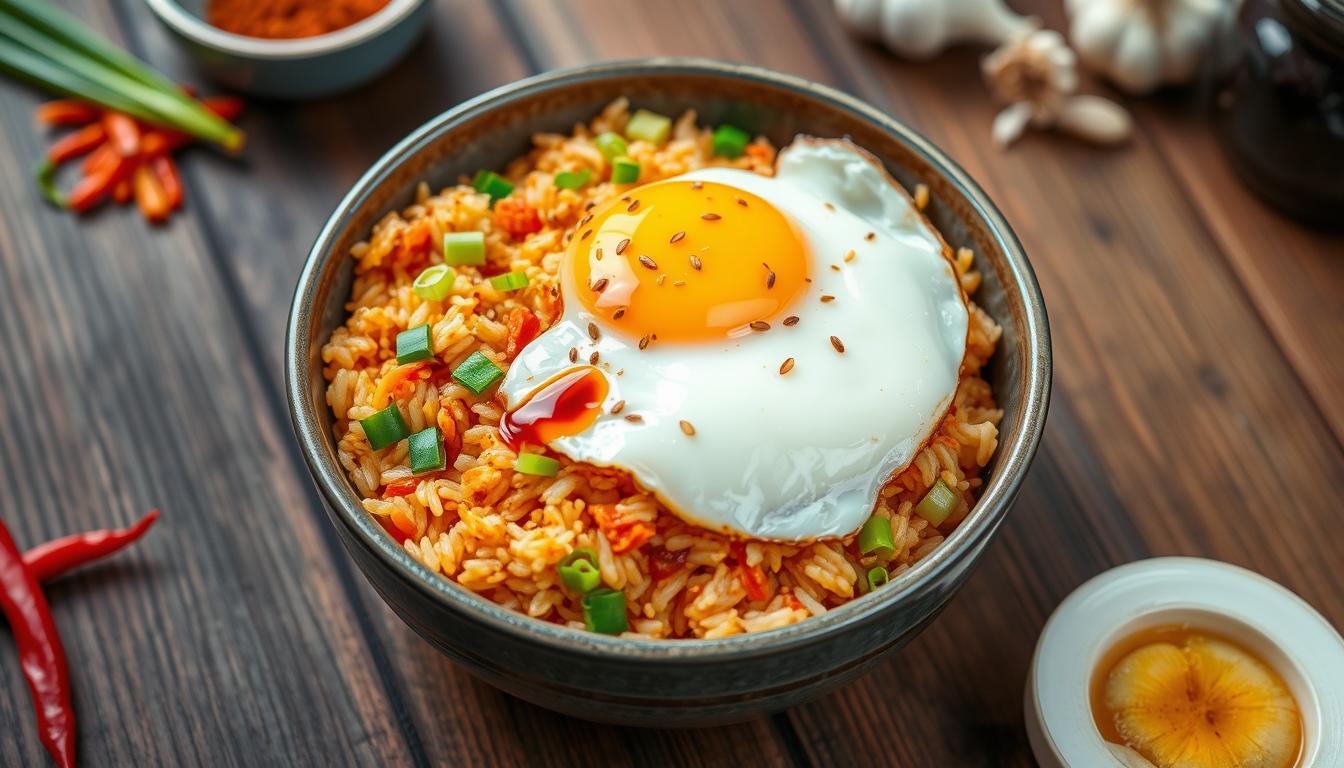Jump to Recipe
Korean food’s vibrant flavors and comforting textures have always captivated me as a food lover. One dish that has won my heart is kimchi bokkeumbap, a delicious kimchi fried rice that is the perfect Korean comfort food.
I always keep this simple rice dish in my kitchen because of its delicious taste and ability to transform leftover rice into other dishes. While I was in Seoul, I found a cozy little restaurant hidden away in a busy alley, and that’s where I tried kimchi bokkeumbap for the first time.
The aroma of the spicy kimchi and cooking rice drew me in, eagerly anticipating my first bite. While I was eating the scorching dish, I noticed that the tangy kimchi, the salty fried rice, and the slightly sweet vegetables all worked together so well.
Ever since that memorable meal, I’ve been determined to make kimchi bokkeumbap taste as delicious in my own kitchen. Making mistakes and learning from them taught me how to make this popular Korean comfort food at home.
I can’t wait to share what I’ve learned with you. This article will talk about the ingredients, methods, and variations that make kimchi bokkeumbap such a tasty and simple rice dish to make, even with rice that you already have.
What is Kimchi Bokkeumbap?
People love kimchi bokkeumbap, a Korean comfort food. It has the spicy and sour flavors of kimchi and the satisfying texture of fried rice. This dish is very common in Korean food and shows how much the country loves fermented vegetables, especially the famous kimchi made from napa cabbage and many different spices.
Making kimchi bokkeumbap with leftover rice results in a delicious meal. We stir-fry the rice with kimchi and a variety of ingredients, including meat, seafood, vegetables, and more. This makes a delicious mix of tastes and textures. Both home cooks and chefs often choose this dish due to its versatility.
It’s different from other fried rice dishes because of the strong, spicy kick from the kimchi. As the kimchi cooks, it releases its bright red color and sour flavor, which gives the rice a complex, deep flavor. People all over the world love this dish’s unique flavor, and Korean restaurants everywhere now serve it all the time.
The kimchi bokkeumbap is not only tasty, but it’s also a quick and easy way to make a comforting meal. Busy families and individuals seeking a tasty, satisfying dish often favor it due to its ease of preparation and adaptability to individual preferences.
Kimchi bokkeumbap is a comfort food that will leave you wanting more, whether you like Korean food or are simply interested in trying new kinds of fried rice.
Ingredients for Kimchi Bokkeumbap
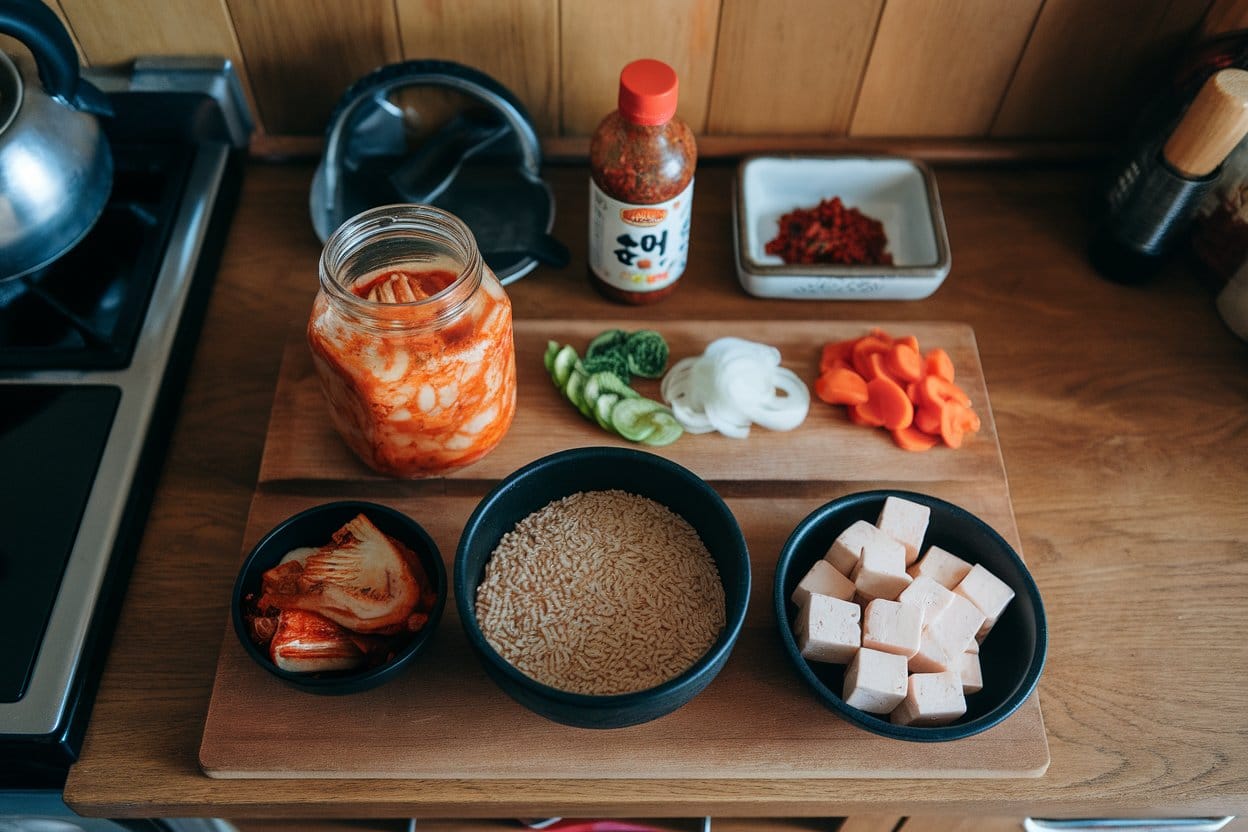
For an authentic and tasty kimchi bokkeumbap, you’ll need a few key ingredients that work well together to make a delicious mix of tastes and textures. Let us look more closely at each part of this Korean fried rice dish that makes it so special.
Kimchi
Kimchi is the main thing that makes kimchi bokkeumbap tasty. There are many kinds of kimchi, but for this recipe, I suggest using aged kimchi that has been well fermented.
The longer the kimchi ferments, the stronger and more complex its flavor gets. This means that the final dish will taste stronger. You can easily mix aged kimchi with other ingredients because it has a soft texture.
Rice
Shortgrain rice is the best kind of rice to use. This type of rice is a little sticky, which helps it stick together and soak up the flavors of the other ingredients. Use rice that is a day old or that you have had before. It has had time to dry out, which makes it easier to fry and less likely to get soggy.
Vegetables
Adding different stir-fried vegetables to your kimchi bokkeumbap will make it taste better, look better, and be healthier. For a classic taste, try onions, carrots, and green onions. These vegetables have a wonderful crunch, and they also add their own unique flavors to the dish.
Protein Options
You can eat kimchi bokkeumbap without adding protein, but many people prefer to do so to make it more filling. Here are some popular choices:
- Tofu: To make this dish vegetarian-friendly, cut firm tofu into small cubes and fry them until golden brown. Then, add them to the rice.
- Spam: In Korean cuisine, people love using diced spam because it gives the food a salty, meaty taste.
- Bacon: You can also add chopped, crispy bacon, which goes well with the sour kimchi and salty rice.
Seasoning and Garnishes
You’ll need a few key seasonings to bring all the flavors together and give your kimchi bokkeumbap its unique taste. We need gochujang, a Korean red pepper paste that is spicy and slightly sweet. It adds to the dish’s depth and heat. To make a flavorful, umami-rich base, you also need soy sauce and sesame oil.
The toppings are the last thing to remember! Adding a fried egg on top is a classic way to make it more filling and healthy. Toast sesame seeds to give it a crunchy, nutty finish.
How to Make Kimchi Bokkeumbap
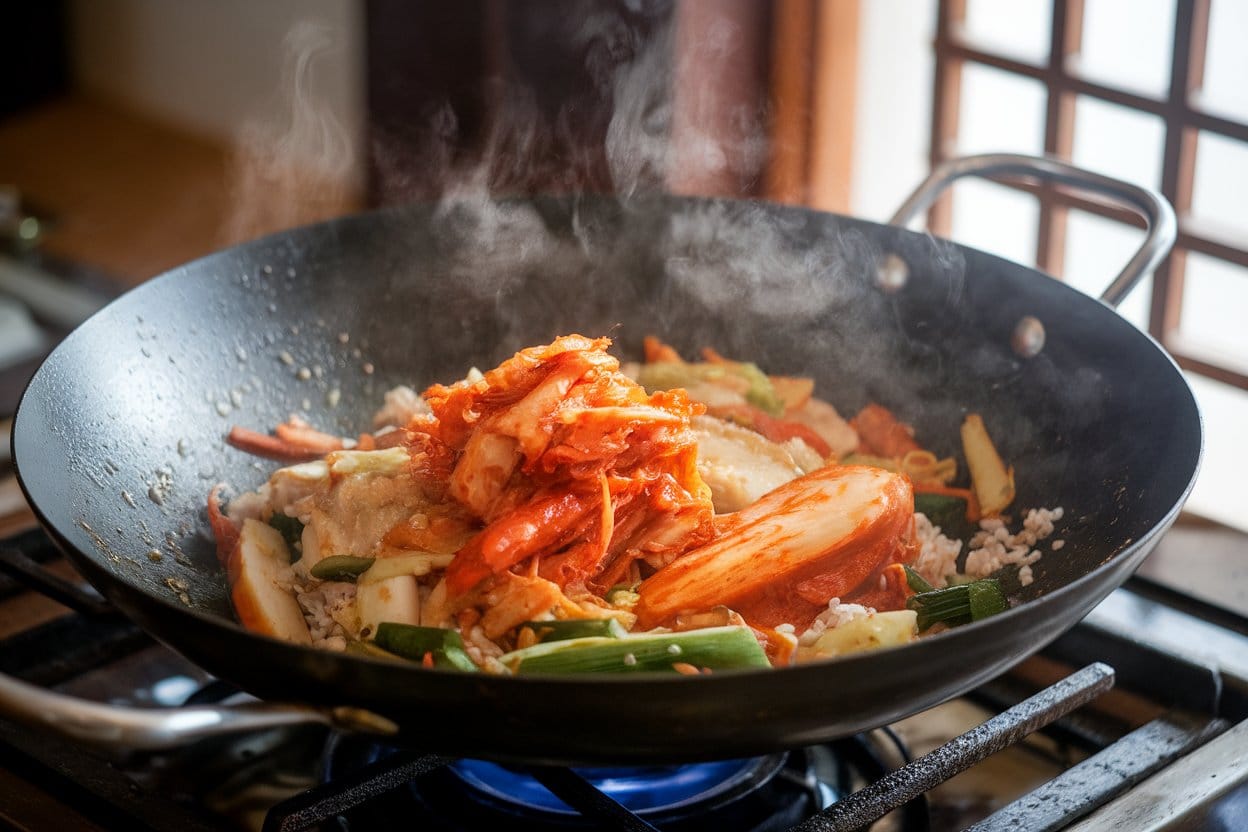
There are only a few simple steps you need to follow to make sure the flavors and textures of your kimchi bokkeumbap are just right. Here are the steps to make delicious Korean fried rice.
Preparing the Ingredients
Preparing all ingredients before cooking is crucial. This will help the cooking go more smoothly and give you the best results.
- When you cut the kimchi into small pieces, make sure to save some of the kimchi juice for later.
- To cook, cut the vegetables you’ve chosen into small pieces.
- If you’re going to use raw proteins like chicken or pork, cook them first and set them aside.
- Put together your spices, like gochujang, soy sauce, and sesame oil, and make sure they are ready to use.
Cooking the Fried Rice
It’s important to use high heat and a wok or large skillet to make the best kimchi bokkeumbap. This will help keep the rice from getting too soft and make sure that everything cooks the same way.
- Set your pan or wok to high heat and add a tablespoon of oil.
- Put the chopped kimchi and vegetables in the pan once the oil is hot. Stir-fry the vegetables for two to three minutes, or until they begin to get soft.
- Continue stirring as you add the cooked rice and proteins to the pan to distribute the flavors evenly and prevent the food from sticking.
- Stir-fry the rice for three to four more minutes, until it’s hot all the way through and the edges are starting to get crispy.
Adjusting Flavours and Textures
One excellent thing about kimchi bokkeumbap is that it’s simple to change the tastes and textures to suit your tastes. To help you find the right balance, here are some tips:
- To taste, add gochujang, soy sauce, and the kimchi juice you set aside. Stir the rice well to mix the flavors.
- You can add more gochujang or even a pinch of Korean red pepper flakes (gochugaru) to make the dish spicier.
- If you prefer a crispier texture, let the rice sit in the pan for an extra minute or two to make the bottom layer a little crispier.
- You can change how much sesame oil you use to finish the dish to your liking.
If you follow these straightforward steps and change the flavors and textures to your liking, you can make a kimchi bokkeumbap that your whole family will love. You can also pair your kimchi bokkeumbap with a side dish or dessert to round out the meal and create a truly satisfying dining experience. For instance, while your fried rice is sizzling on the stove, you might want to explore a nobake baileys cheesecake recipe as a creamy and indulgent treat to enjoy afterward. Balancing the bold, spicy flavors of the bokkeumbap with a smooth, sweet dessert is a sure way to impress everyone at the table.
Variations on the Classic Kimchi Bokkeumbap Recipe

Kimchi bokkeumbap offers a multitude of applications. The recipe is simple to change to fit your tastes or dietary needs. You can easily make a dish vegetarian by leaving out the meat and adding tofu, mushrooms, or more vegetables. This way, you can enjoy the strong flavors of kimchi fried rice without giving up your plant-based lifestyle.
Seafood enthusiasts can enhance the flavor of kimchi bokkeumbap by adding octopus, shrimp, or squid. The salty tastes of the seafood go well with the sour and spicy tastes of the kimchi, making a delicious balance that will wow your taste buds.
People often add a slice of melted cheese on top of their kimchi bokkeumbap as a new twist on the traditional dish. The cheese’s smooth, gooey texture makes the dish feel comforting, and its mild flavor balances out the kimchi’s strong flavor.
Most people choose American cheese, but you can try other kinds to find the one that goes best with your food. When you make your bokkeumbap, don’t be afraid to try out different brands and types of chili.
Traditional Napa cabbage kimchi is the most well-known type, but there are also a lot of other regional and specialty kimchis to try. You can make your fried rice taste different by adding radish kimchi, cucumber kimchi, or even white kimchi. This will help you find new favorites and keep things exciting in the kitchen.
Finally, the versatility of kimchi bokkeumbap is what makes it so great. You can enjoy this popular Korean comfort food in a way that suits your tastes, whether you’re a vegetarian, a seafood lover, or a cheese lover. Try out different brands of kimchi, different types of ingredients, and regional variations. You might find your new favorite recipe!
Serving and Enjoying Kimchi Bokkeumbap
Knowing when to eat Kimchi bokkeumbap is critical so that you can enjoy its delicious tastes and textures. This Korean comfort food tastes best when it’s hot and fresh from the stove. If you mix the crunchy rice with the sour kimchi and salty seasonings, you get a delicious mix that will make your taste buds dance.
Ideal Serving Temperature
It’s important to serve kimchi bokkeumbap at the right temperature so that you can fully enjoy its flavors. The dish should be very hot, so the smells can fill the room and tempt your taste buds. Also, the heat helps the flavors blend together, making the whole experience of eating more satisfying.
Complementary Side Dishes
Even though kimchi bokkeumbap tastes excellent by itself, it’s even better when you eat it with traditional Korean side dishes called banchan. These are some popular choices:
- Stir-fried vegetables, such as spinach with herbs or courgettes cooked in butter, are delicious.
- Pickled radishes or other vegetables undergo fermentation
- I would like to serve something light, like kimchi jjigae, to go with the rich fried rice.
These side dishes combine different tastes and textures to make your meal more interesting and complement kimchi bokkeumbap.
Storing Leftovers
If you have extra food, which is very unlikely, don’t worry! You can easily store kimchi bokkeumbap and heat it up again later for a quick and tasty meal. After the fried rice has cooled, put it in a container that won’t let air in and place it in the fridge.
It’ll be fine for up to three days. Warm up the kimchi bokkeumbap in a pan with a little oil or butter when you’re ready to eat the rest of the food. Stir-fry the rice over medium-low heat until it’s warm all the way through and starts to get a little crispy.
This method restores the dish’s texture and flavor, ensuring you can relish it to the same extent as the day of preparation.
Why Kimchi Bokkeumbap is a Beloved Korean Comfort Food
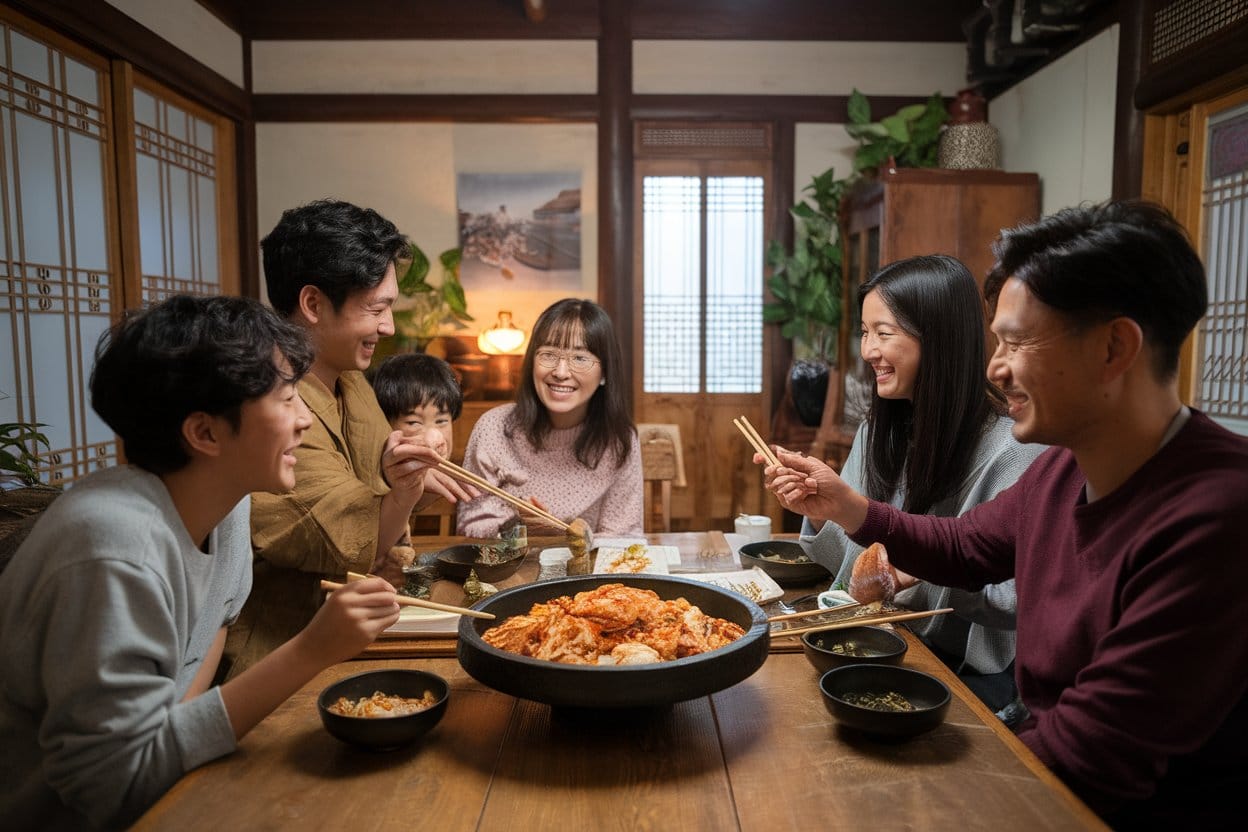
There are a lot of reasons why kimchi bokkeumbap is such a beloved dish in Korean culture. When you mix the spicy, sour, and savory flavors of the kimchi with the hearty texture of the fried rice, you get a very satisfying and comforting meal.
This dish makes you feel warm all the way through, so it’s ideal for cozy nights at home or friendly get-togethers with family and friends. Another reason it’s so popular is that it’s not too expensive.
Making kimchi bokkeumbap is a wonderful way to use up extra rice and other ingredients that are sitting in your fridge. Because it’s so flexible, you can do it your way and make a tasty meal with little cost and work. This makes it a wonderful choice for busy professionals, students, or anyone else who wants to make quick meals without giving up taste.
Adding kimchi to this dish also gives you the health benefits that come with eating fermented foods. There are lots of beneficial bacteria in kimchi that can help your digestion, boost your immune system, and improve your overall health.
The fermentation process also makes the umami flavor of the kimchi stronger. This gives the fried rice more depth and complexity, which is what makes people keep coming back for more. Kimchi bokkeumbap is a tasty way to add healthy food to your diet, so you can enjoy it without feeling guilty.
Basically, kimchi bokkeumbap is a popular Korean comfort food because it’s tasty, cheap, simple to make, and even beneficial for you. Its ability to make people feel warm, satisfied, and nostalgic has made it a favorite among Koreans and food lovers all over the world.
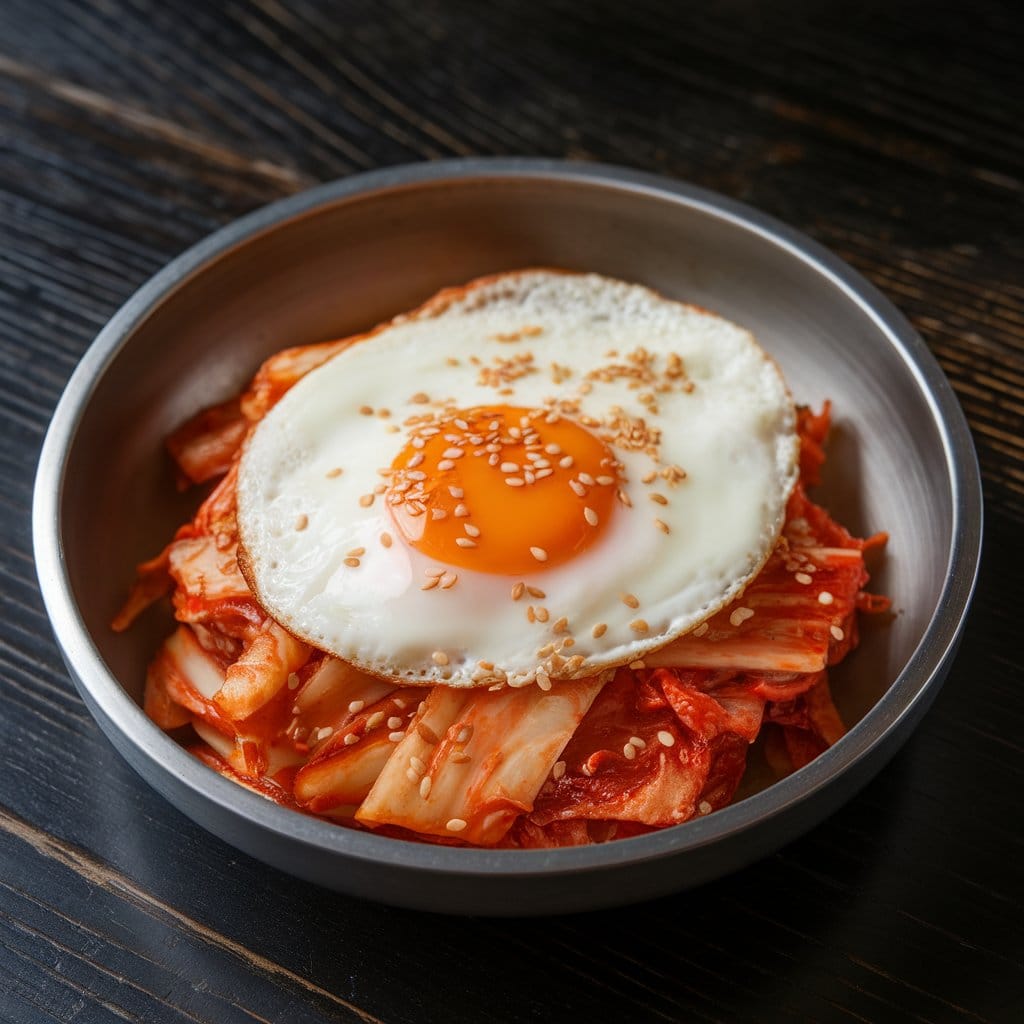
Kimchi Bokkeumbap
Ingredients
Method
- Prepare Ingredients: Chop the kimchi, vegetables, and protein of choice. Make sure all ingredients are ready to use.
- Heat the Pan: Heat a tablespoon of vegetable oil in a large skillet or wok over high heat.
- Cook Vegetables and Kimchi: Add the chopped onion, carrot, and kimchi to the skillet. Stir-fry for 2-3 minutes until the vegetables start to soften and the kimchi becomes fragrant.
- Add Rice and Protein: Add the cooked rice and your chosen protein to the skillet. Stir well to combine, breaking up any clumps of rice.
- Season: Stir in gochujang, soy sauce, and kimchi juice. Mix everything well and continue stir-frying for another 3-4 minutes until everything is heated through and slightly crispy.
- Finish: Drizzle sesame oil over the rice and give it a final stir. Garnish with toasted sesame seeds and a fried egg on top if desired.
Notes
- Use day-old rice for the best texture—it absorbs the flavors better and won't become too soft.
- If you want a spicier kick, add more gochujang or sprinkle some gochugaru (Korean red pepper flakes).
FAQ
What is kimchi bokkeumbap?
Kimchi bokkeumbap, a common Korean fried rice dish, combines kimchi’s sour and spicy flavors with the comforting texture of fried rice. There’s no better way to use up extra rice, and you can change the flavors by adding different proteins and vegetables.
What type of kimchi should I use for kimchi bokkeumbap?
For optimal results, use kimchi that has undergone prolonged fermentation or aging. It has a stronger flavor and a softer texture that work well in the dish. You can try making kimchi with different vegetables and herbs, like radish or cucumber, to get different tastes.
Can I make kimchi bokkeumbap vegetarian?
Of course! Adding tofu as a protein source or leaving out the protein altogether makes kimchi bokkeumbap easily vegetarian. With just the kimchi, vegetables, and seasonings, the dish will still taste excellent and fill you up.
What are some popular variations of Kimchi bokkeumbap?
People often change the original recipe by adding seafood such as shrimp, squid, or a slice of American cheese on top for a creamy, melty finish. There are also regional differences. For example, in some parts of Korea, the dish is made with local ingredients or using different cooking methods.
How should I serve kimchi bokkeumbap?
The best way to eat kimchi bokkeumbap is hot, straight from the stove. Serve it as a side dish with traditional Korean dishes like pickled radishes, stir-fried vegetables, or a light soup like kimchi jjigae.
How long can I store leftover kimchi bokkeumbap?
Put any leftovers in a container that won’t let air in and refrigerate for up to three days. Stir-fry the leftover rice in a pan with a little butter or oil until it’s warm all the way through and starts to get crispy.
Why is kimchi bokkeumbap considered a beloved Korean comfort food?
Kimchi bokkeumbap, with its spicy, sour, and sour flavors, is a popular Korean comfort food that fills you up and makes you feel better. It also doesn’t cost much, takes little time to make, and has the health benefits of fermented foods like kimchi.

